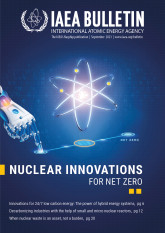
If you would like to learn more about the IAEA’s work, sign up for our weekly updates containing our most important news, multimedia and more.
Verifying spent nuclear fuel in deep geological repositories
Eva Morela Lam Redondo

Entrance to ONKALO, Finland’s deep geological repository for spent nuclear fuel. (Photo: Posiva Oy)
As the world looks to alternatives to fossil fuels to combat climate change, several countries are developing nuclear power programmes to provide a sustainable source of low carbon energy. Countries operating nuclear reactors are responsible for providing geological disposal capacity for high-level radioactive waste. The internationally well-established approach for such disposal is a mined deep geological repository (DGR). Canada, Finland, France, Sweden and Switzerland have the most advanced DGR programmes.
Examples of the new facilities under development include the Encapsulation Plant (EP) and DGR in Finland — the former is where spent fuel will be safely sealed in disposal canisters, the latter is where the canisters will then be permanently and safely stored. Both are required to comply with Finland’s international legal obligations to allow for the IAEA’s verification of the peaceful use of nuclear material.
As safeguards inspectors, we need to be able to verify the spent nuclear fuel before it is transferred to the EP and DGR facilities. We then implement safeguards measures to confirm that the spent fuel is not diverted or substituted, and that the facilities are not used for undeclared purposes.
The IAEA fulfils its nuclear verification mission by implementing a series of technical measures — safeguards — to oversee nuclear facilities, materials and activities. These measures allow the IAEA to independently verify that States are fulfilling their legal responsibility to use nuclear material only for peaceful purposes. States accept these measures by entering into safeguards agreements with the IAEA. Consequently, by performing safeguards, the IAEA can provide the world with credible assurances that States are meeting their nuclear non-proliferation commitments.
“Finland’s collaboration with the IAEA exemplifies a strong commitment to fulfil our international non-proliferation obligations through effective safeguards,” said Marko Hämäläinen, Section Head of Nuclear Materials Safeguards at the Radiation and Nuclear Safety Authority (STUK) in Finland.
The EP and DGR facilities present challenges and opportunities for the application of safeguards, and innovative solutions are being developed so that IAEA safeguards inspectors can verify the stored nuclear material. Accessing the DGR, which is almost 500 metres deep underground and is scheduled to operate for the next 100 years, is one of these challenges. When operational, the EP and DGR will be the first facilities of their kind in the world under a comprehensive safeguards agreement with the IAEA. IAEA inspectors are therefore required to devise new and sustainable safeguards approaches to verify difficult to access nuclear material now and into the distant future.
“As safeguards inspectors, we need to be able to verify the spent nuclear fuel before it is transferred to the EP and DGR facilities. We then implement safeguards measures to confirm that the spent fuel is not diverted or substituted, and that the facilities are not used for undeclared purposes,” said Courtney Ames, Nuclear Safeguards Inspector at the IAEA. “The EP and DGR facilities present a challenge for IAEA safeguards inspectors in terms of maintaining the continuity of knowledge during and after the transfer of the spent fuel, especially with limited physical access to the geological repository. By utilizing novel techniques, teamwork and careful analysis, our safeguards objectives can be achieved.”
Collaboration between the IAEA, the European Commission and the STUK is essential for developing safeguards measures and techniques, including through the development and testing of spent nuclear fuel verification technologies prior to disposal of the spent fuel.
In 2012, the IAEA initiated the Encapsulation Plant and Geological Repository (EPGR) project to specifically address the safeguards implementation challenges posed by the new types of facilities. Working closely with counterparts, the project has implemented a comprehensive approach that incorporates safeguards by design (SBD) principles, which can minimize operational impacts at the DGR. SBD involves integrating safeguards considerations early in the planning and design phases of a facility, with continued integration throughout its construction, operation and decommissioning. In the case of Finland, SBD enables both IAEA and Euratom safeguards inspectors, and the national authority (STUK), to efficiently fulfil their duties without disrupting the operations of the EP and DGR facilities.
“Through the EPGR project, we have implemented safeguards by design. This proactive approach reduces the need for retrofits and saves valuable resources for the operator, STUK, the IAEA and the European Commission,” Hämäläinen said.
Other recently developed concepts and measures, including remote monitoring systems, are being installed. By using remote monitoring systems to observe the location of the nuclear material, the IAEA can reduce in-field inspections and, in turn, lower the carbon emissions arising from travel to and from facilities. Techniques like seismic monitoring and laser-based containment systems could also play a role in reducing inspections. Seismic monitoring can detect any undeclared penetrations of the DGR’s surrounding rock, whereas laser-based containment systems analyse the welding profile of the container’s lid to produce a unique natural ‘signature’ which, if altered, would indicate that a canister has been opened.
By 2025, the EP and DGR facilities in Finland will be fully operational for the emplacement of spent nuclear fuel. Together, through collaboration and innovation, the IAEA, the European Commission and the STUK are implementing effective and efficient safeguards that achieve the IAEA’s verification objectives, while ensuring minimal impact to the operation of the facilities. By incorporating SBD, the EP and DGR facilities will provide a solution for handling and disposing of spent nuclear fuel, supporting the transition to low carbon nuclear power, and facilitating the IAEA’s verification of nuclear material and technology.

